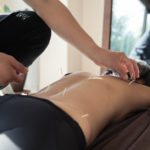Scoliosis

What is scoliosis?
Scoliosis is a sideways curve of the spine, either “S” shaped or “C” shaped, that occurs most frequently in girls over the age of 10. The curves usually appear during early adolescence. All told, some degree of scoliosis affects two to three percent of the population. The vast majority of these cases – between 80 and 85 percent – are classified as “idiopathic”, meaning that the cause is unknown.
Less common forms of scoliosis include congenital scoliosis, a rare condition present at 1 in 10,000 births. Here, too, the cause is unknown, but surgery is needed to correct the curve. Another form of the disorder, neuromuscular scoliosis (also called myopathic scoliosis), can develop in muscular dystrophy or cerebral palsy patients who cannot walk.
What are the symptoms of scoliosis?
Idiopathic scoliosis rarely causes pain and does not require treatment. However, if there are symptoms, they can include backache or low back pain, as well as a tired feeling in the spine after lengthy sitting or standing, which may be due in part to uneven hips or shoulders (one shoulder higher than the other). Call the doctor if severe back pain develops, particularly if it is associated with weakness of the limbs or numbness.
What are the causes of scoliosis?
Scoliosis tends to run in families, and about 20 percent of those with affected relatives develop the condition. Researchers have identified a gene, CHD7, related to idiopathic scoliosis and have determined that variations in this gene increase susceptibility to scoliosis but have not discovered how this comes about.
How is scoliosis diagnosed?
Doctors usually can make a diagnosis by physical examination, checking to see if the shoulders are level, the head is centered and opposite sides of the body look level. An x-ray may be needed for correct measurement of the curve.
Many children are screened at school and by pediatricians and primary care doctors for scoliosis with the Adam’s Forward Bend Test, whichmerely requires kids to bend forward, letting their arms dangle and keeping their feet together and knees straight. This position reveals the spinal curvature typical of scoliosis as well as whether one side of a child’s rib cage is higher than the other, also a sign of scoliosis. However, the forward bend test misses about 15 percent of cases because it doesn’t show abnormalities in the lower back. For this reason, many experts do not recommend it as the sole screening method for scoliosis. Girls are typically screened twice, at age 10 and 12, and boys once at age 12 or 13 years.
Overall, x-rays are the most accurate way to diagnose scoliosis and determine its severity. Follow-up x-rays may be needed every few months to see if the curve is worsening. Parents should ensure that all protective measures are being taken with these frequent x-rays since exposure to the radiation presents a possible increased risk of cancer later in life.
Since scoliosis tends to run in families, parents, particularly those who have the disorder, can look for signs of it in their children. Be on the lookout for one shoulder higher than the other, uneven hips, or one side of the rib cage sticking out more than the other. These signs may be easier to spot when kids are bathing or swimming and hard to see when they’re fully clothed.
What is the conventional treatment of scoliosis?
Very mild curves don’t require any type of treatment. The Scoliosis Research Foundation estimates that only 10 percent of people with scoliosis – those with curves greater than 20 degrees – need treatment of any kind.
When a child is still growing and the curve is less than 25 degrees, the only medical attention needed is a checkup every four to six months to see whether or not the curve is worsening. If it is – or if it was greater than 25 degrees to start with – a customized back brace may be recommended for children who are still growing. Patients wear the brace daily for a specified number of hours (often between 18 and 20 per day). Among youngsters and teens who are still growing or when braces have failed to correct the curve, surgery to straighten the spine is considered necessary when curves are 45 degrees or more and worsening.
What therapies does Dr. Weil recommend for scoliosis?
Dr. Weil suggests alternatives to surgery including osteopathic manipulation and therapeutic yoga, which can help lengthen and strengthen the muscles that support the spine. Depending on how severe the scoliosis is, he notes that manual manipulation and breathing exercises can be helpful for pain relief and to ensure good breathing habits.









